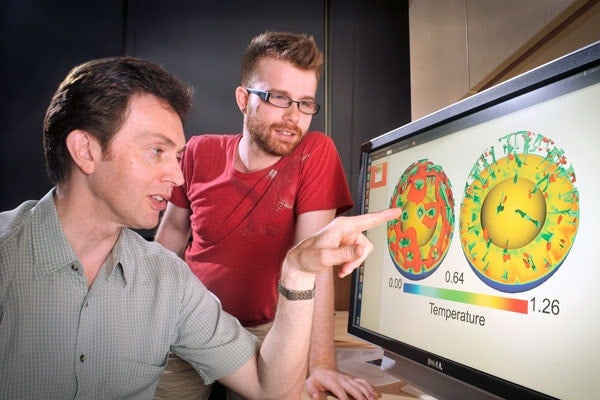
What's going on beneath the planet's surface
Published: July 2, 2013
Julian Lowman is a physicist with the University of Toronto Scarborough who studies the internal dynamics of the Earth and of terrestrial planets beyond our solar system, especially the many large ‘super-Earths’ which have recently been discovered around other stars.
Using the Canadian SciNet supercomputer network Lowman runs complex mathematical models simulating what's going on beneath the surface of our world. Among other things, his work might help predict whether the conditions needed for the development of terrestrial life might exist on other planets.
Can you tell us a bit about your work?
Our area of interest is the evolution of planets. A planet in the most rudimentary terms has a hard outer crust, a rocky mantle underneath that, and a dense metallic core. It’s the evolution of the mantle and how it rids itself of heat that determines the evolution of the entire planet. In the Earth's case mantle convection is manifested by plate tectonics, and plate tectonics is responsible for continental drift. And continental drift plays into all of these areas of science, everything from biological evolution to the storing of carbon dioxide that affects climate of the planet over a long-term scale. It affects the rotation rate of the planet, it affects the gravity field of the planet and it is likely very important in the generation of the magnetic field.
You name it, plate tectonics probably affects it.
What questions are you trying to answer?
I suppose the one most interesting to most people is whether other planets have mobile surfaces, and why the Earth’s surface is mobile. This is one of the reasons plate tectonics is so interesting now that we’re starting to discover all of these exoplanets. We've come to understand the importance of plate tectonics in the evolution of the Earth and the fact that without plate tectonics we might not have terrestrial life. If it wasn't for plate tectonics there wouldn't be any human beings.
Why wouldn't terrestrial life have developed?
Because we wouldn't have continents. You've got essentially a battle between continents being pushed above sea level and erosion wanting to wash them down below sea level. Given the 4.6 billion year lifetime of the Earth, erosion would have washed all the land above sea level into the oceans by now. So all the land we have is a result of mantle convection pushing around the surface. In fact, as time goes on we're gaining continental surface area.
How do you do your research?
It would be impossible to do this work without a facility like SciNet. We do 3D computational fluid dynamics. The mantle's very interesting. On very short time scales mantle rocks act like a solid so they do things like transmit seismic waves. But over long geologic time scales they flow by what’s called creep mechanisms. So they're able to behave like a fluid but the evolution takes place very slowly, on the order of centimeters per year. Mantle rocks move at the rate your fingernails grow.
To model the evolution of a material that flows so slowly you can speed up that entire process on a computer. But the biggest problem we have is it’s very computationally intensive. You need very high resolution and you're doing things in 3D and you have to step things forward in time to simulate hundreds of millions to billions of years. They are very large computational problems. And the bigger the planet the more computationally intensive the problem becomes.
Are you trying to model Earth-like planets?
We’re looking at terrestrial planets, that is, rocky planets. Venus and Mars don’t have plate tectonics. There are no other bodies in the solar system that have plate tectonics. The oceans may play a very important role in creating plate tectonics. What you can get is something called stagnant lid convection, where the convection goes on underneath the surface, but the surface is so rigid that what's going on in the interior can't actually get enough traction on the base of the plates to get the base to move. You can only get the surface to move if you've got some weak points on the surface, which on Earth are the oceanic ridges and the subduction zones.
I've been looking at what allows mantle convection to be expressed as plate tectonics and whether this is more likely on super-Earths. Is a super-Earth going to be big enough that it doesn’t get to that decoupled stage like Venus and Mars, so that plate tectonics is therefore bound to appear? Or does plate tectonics need water? Is that the key?
Kurt Kleiner is a writer with the University of Toronto Scarborough.



